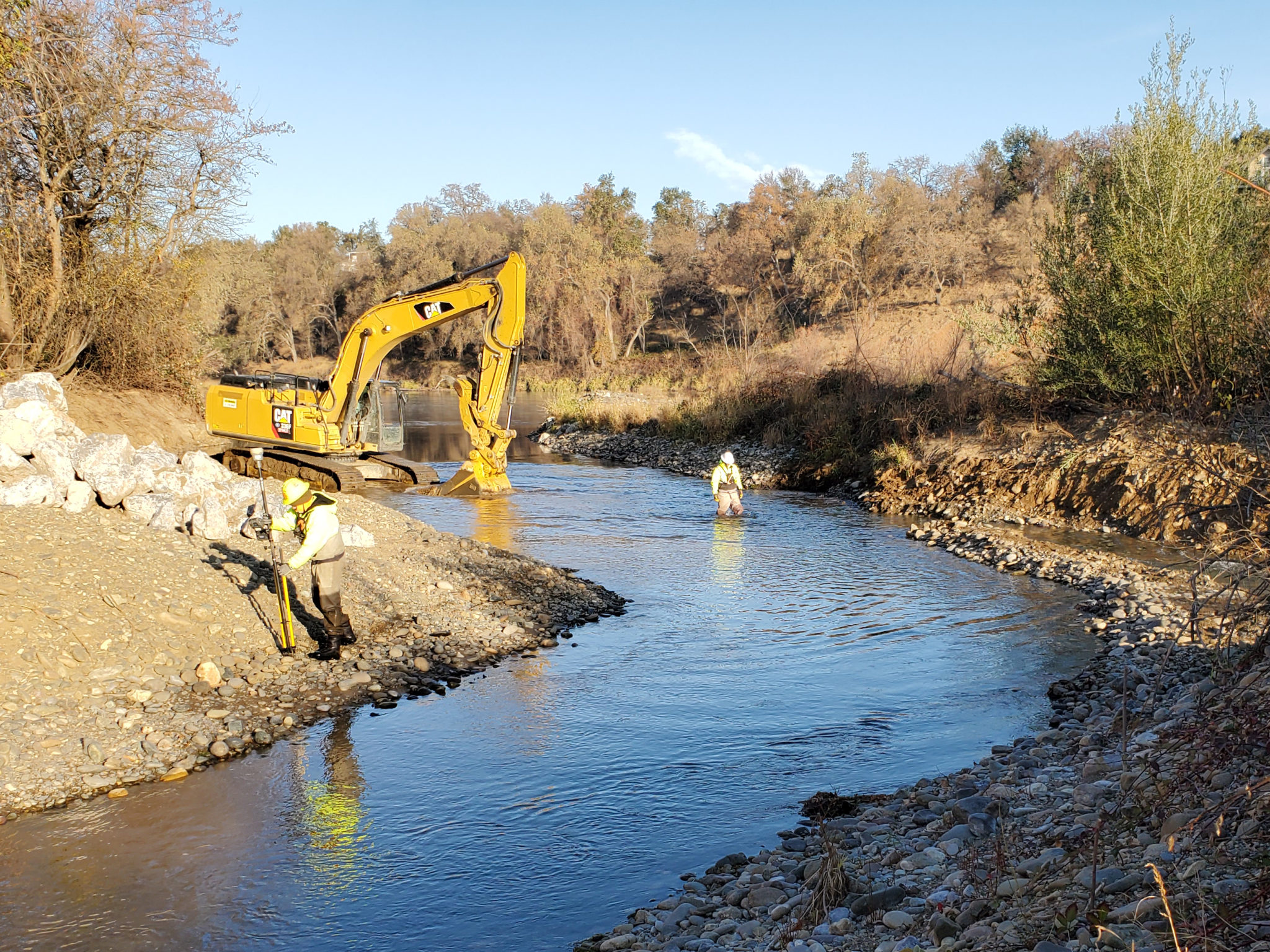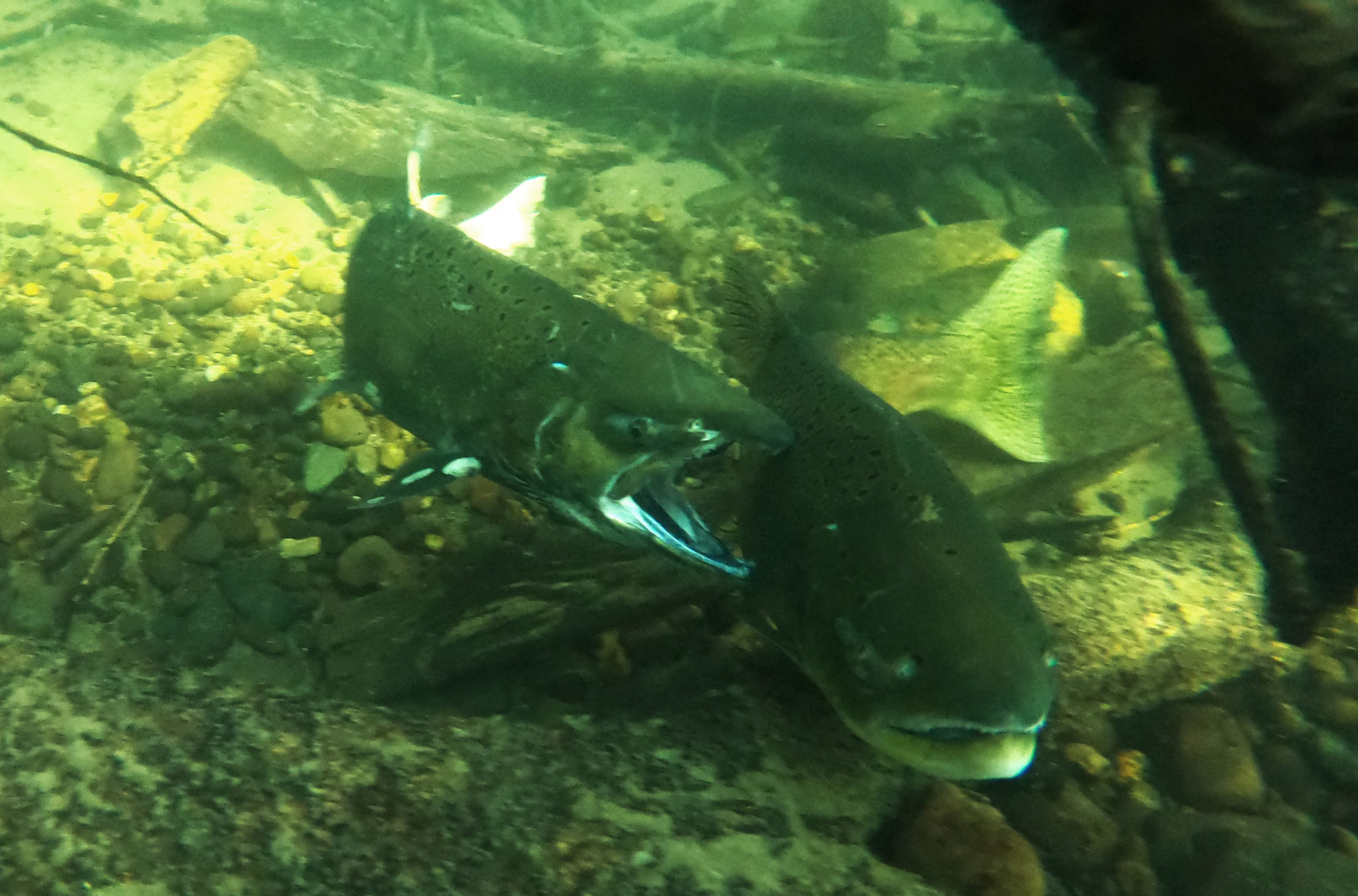- The Yurok Tribe’s years of experience restoring river landscapes in Northern California was critical for River Partners’ salmon-recovery projects on the Sacramento River.
- The quick return of imperiled salmon to new Sacramento River side channels is a testament to the value of strong, diverse partnerships that get results.
During cold winter months on the Sacramento River, water roars down the nearly 400-mile long waterway at six feet per second. Silt, sand, and clay tumble along in the rough water, and so do tiny juvenile salmon, caught up in the hard, fast current on their way to the ocean.
Young salmon aren’t meant to grow up in these conditions. They aren’t strong swimmers, and in the river’s main channel there’s nowhere for them to go to escape predators and the often relentless current. Historically, they’ve depended on the river’s slower-moving side channels, narrow arms of calmer water that branch away from the main waterway. Over the last century, people have modified the river and its side channels, which has eliminated or degraded many of these once-abundant habitats.
“A river the size of the Sacramento is a scary place if you’re two or three inches long,” says Aaron Martin, a Yurok Tribe habitat restoration biologist. “Side channels are refuges from predation and provide high-quality rearing habitat. If you can build a side channel, keep it flowing year-round and provide slow water habitat with a bunch of cover, it’s going to be very useful for these juveniles.”
Leveraging Decades of Yurok Expertise

Roughly 90 percent of Chinook salmon spawning habitat in California has been lost since the late 1840s, when people began building dams and significantly altering the courses of California rivers and streams. Today, the population of Sacramento River winter run salmon is historically low, and the species is listed as endangered under the Endangered Species Act.
In 2019, River Partners asked the Yurok Tribe to help us revive and reconnect side channels along the Sacramento River between Keswick Dam and Red Bluff. The Yurok have years of experience restoring river landscapes along the Klamath River and its principal tributary, the Trinity River, but the Anderson River Park side channel project marks the first time the Yurok crew worked on the Sacramento. Like the Klamath, the Sacramento River provides important habitat for endangered Chinook salmon.
Traditionally, salmon were a primary food source for the Yurok. Today, these endangered migrants still have an important place in the Yurok culture. “The Klamath River and its fish are the lifeblood to the Yurok,” says Martin. “The year and the seasons are all timed with what’s happening on the river and the surrounding environment.”
River Partners depended on the Yurok’s knowledge and years of experience constructing side channels to turn our plans for the Sacramento River side channel into real, functional habitat. “The ecology, the existing vegetation, all those things are all taken into consideration,” says Martin. “We let the conditions there help determine what’s appropriate for the design. If we go one way, for example, we’re taking out some invasive plants. And if we don’t go another way, we’re saving some native trees.”
Once excavated, the side channels were finished with submerged structures – branches, root wads from fallen trees, and sometimes entire trees – that provide hiding places for the vulnerable young salmon.
Proof of Concept

When the first of two side channels was complete, its impact was startlingly immediate. Chinook salmon were spotted taking refuge in the new habitat, including dozens of members of the critically endangered winter-run. The project’s success is a humbling and inspiring example of how partnerships with important stakeholders like the Yurok can make a difference in the vitality of our river ecosystems and the wildlife that depend on them.
In the fall of 2020, River Partners received funding from the U.S. Bureau of Reclamation to complete additional work on six Sacramento River salmon habitat project sites. Our work with the Yurok Tribe at Anderson River Park was the proof-of-concept that helped River Partners and our partners move forward with salmon habitat restoration in other parts of the Sacramento Valley. We also look forward to continuing our partnership with the Yurok in restoring habitat along the Klamath River between Oregon and California after four of six dams along the river are removed over the next three years. As the largest dam removal in U.S. history, the action will restore salmon access to more than 400 miles of upstream habitat, boost water quality, and benefit local communities and economies that depend on a healthy river.
River Partners is honored to work with the Yurok and with other critical project partners on the Sacramento River side channel projects, including CSU Chico, the Sacramento River Forum, California Department of Water Resources, California Department of Fish and Wildlife, Pacific States Marine Fisheries Commission, Resource Conservation District of Tehama County, and Sacramento River Settlement Contractors. Central Valley Project Improvement Act funds made this important and inspiring project possible.








